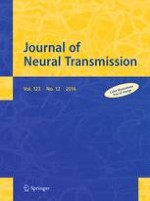Published in:

01-12-2016 | Neurology and Preclinical Neurological Studies - Original Article
Repetitive transcranial magnetic stimulation (rTMS) combined with cognitive training is a safe and effective modality for the treatment of Alzheimer’s disease: clinical experience
Authors:
Jose Martin Rabey, Evgenia Dobronevsky
Published in:
Journal of Neural Transmission
|
Issue 12/2016
Login to get access
Abstract
Alzheimer’s disease (AD) is the most common type of dementia among the elderly. Common treatments available and non-pharmacological interventions have their limitations, and new therapeutic approaches are critically needed. Transcranial magnetic stimulation (TMS) is a non-invasive technique that generates an electric current-inducing modulation in cortical excitability. The previous clinical trials showed that combinations of rTMS and cognitive training (rTMS-COG), as provided by the NeuroAD medical device system, offer a novel, safe, and effective method improving mild-to-moderate AD patients. In this article, we present our experience with rTMS-COG treatment, in clinical settings, of 30 mild-to-moderate AD patients that received rTMS-COG commercial treatments in two clinics for 1-h daily sessions, 5 days per week, for 6 weeks (30 sessions). Five patients returned for a second treatment. ADAS-Cog and MMSE scores were measured pre- and post-treatments. The main analyses were conducted on patients who received 1 treatment (n = 30). Data received from the five returning patients were analyzed separately. The effect of rTMS-COG treatment was statistically significant regarding both ADAS-Cog (−2.4 point improvement, PV <0.001) and MMSE (+1.7 points improvement, PV <0.001) scores. About 80 % of patients gained some cognitive improvement following NeuroAD treatment, with more than 60 % improving by more than two points, for a minimum of 9 months. The Neuronix NeuroAD System was shown to be a safe and effective non-invasive modality for cognitive improvement of Alzheimer patients, with measurable outcomes lasting, in some of them, for up to 1 year, following completion of the 6-week daily intervention course (a carryover effect).





